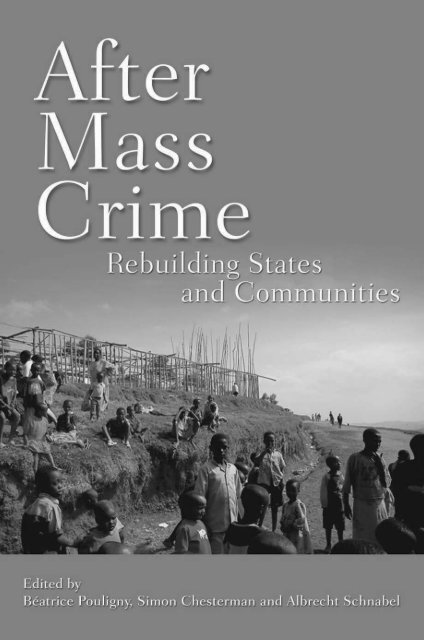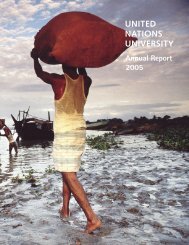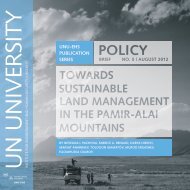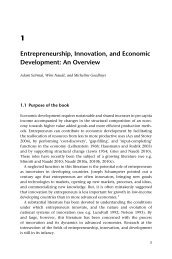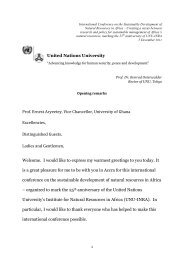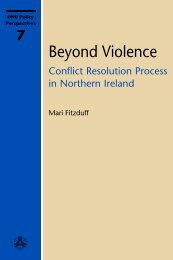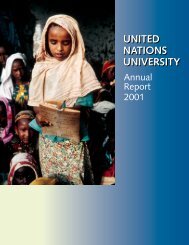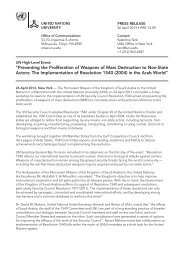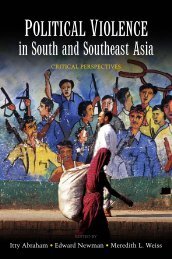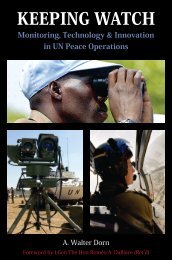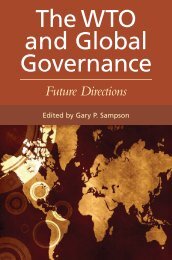After mass crime: Rebuilding states and communities
After mass crime: Rebuilding states and communities
After mass crime: Rebuilding states and communities
Create successful ePaper yourself
Turn your PDF publications into a flip-book with our unique Google optimized e-Paper software.
<strong>After</strong> <strong>mass</strong> <strong>crime</strong>: <strong>Rebuilding</strong> <strong>states</strong><strong>and</strong> <strong>communities</strong>Edited by Béatrice Pouligny, Simon Chesterman <strong>and</strong>Albrecht SchnabelaUnited NationsUniversity PressTOKYO u NEW YORK u PARIS
ContentsList of tables...........................................................List of contributors....................................................Acknowledgements . . . . . . . . . . . . . . . . . . . . . . .............................viiviiixivIntroduction: Picking up the pieces . . . . . ............................. 1Béatrice Pouligny, Simon Chesterman <strong>and</strong> Albrecht SchnabelI. Methodology <strong>and</strong> ethics1 Methodological <strong>and</strong> ethical problems: A trans-disciplinaryapproach ........................................................... 19Béatrice Pouligny, Bernard Doray <strong>and</strong> Jean-Clément Martin2 Contested memories: Peace-building <strong>and</strong> communityrehabilitation after violence <strong>and</strong> <strong>mass</strong> <strong>crime</strong>s –A medico-anthropological approach ............................. 41Roberto BeneduceII. Individuals <strong>and</strong> <strong>communities</strong>3 The uses <strong>and</strong> abuses of culture: Cultural competence inpost-<strong>mass</strong>-<strong>crime</strong> peace-building in Cambodia . . . . . . . . . . . . . . . . . . . . 71Maurice Eisenbruch
viCONTENTS4 Intimate enemies: Reconciling the present in post-war<strong>communities</strong> in Ayacucho, Peru.................................. 97Kimberly Theidon5 Origins <strong>and</strong> aftermaths: The dynamics of genocide in Rw<strong>and</strong>a<strong>and</strong> their post-genocide implications ............................. 122Scott Straus6 ‘‘You can’t run away’’: Former combat soldiers <strong>and</strong> the role ofsocial perception in coping with war experience in theBalkans ............................................................ 142Natalija BašićIII. Memories <strong>and</strong> representations7 Mass murder, the politics of memory <strong>and</strong> post-genocidereconstruction: The cases of Rw<strong>and</strong>a <strong>and</strong> Burundi .............. 165René Lemarch<strong>and</strong> <strong>and</strong> Maurice Niwese8 Speaking from the shadows: Memory <strong>and</strong> <strong>mass</strong> violence inBali ................................................................ 190Leslie Dwyer <strong>and</strong> Degung Santikarma9 Shaping political identity through historical discourse:The memory of Soviet <strong>mass</strong> <strong>crime</strong>s .............................. 215Thomas SherlockIV. Insiders <strong>and</strong> outsiders10 External contributions to post-<strong>mass</strong>-<strong>crime</strong> rehabilitation ....... 243Louis Kriesberg11 Re-imagining peace after <strong>mass</strong> <strong>crime</strong>: A dialogical exchangebetween insider <strong>and</strong> outsider knowledge . . ...................... 271Roberta Culbertson <strong>and</strong> Béatrice PoulignySelected Bibliography ................................................ 288Index .................................................................. 307
1Introduction: Picking up the piecesBéatrice Pouligny, Simon Chesterman <strong>and</strong> Albrecht SchnabelInterventions in the aftermath of <strong>mass</strong> violence tend to focus on war<strong>crime</strong>strials today, elections <strong>and</strong> institution building tomorrow. Theframe of reference is macro, at the level of the state, although the experienceof <strong>mass</strong> <strong>crime</strong> by a population is also micro, at the level of the community.When selective interventions take place at this level, they aregenerally premised on Western health models, infrastructures <strong>and</strong> institutions.In application, these programs have ranged too often from the ineffectiveto the actively unhelpful. A key reason for this is that insufficientattention has been paid to the radical transformations in beliefsystems <strong>and</strong> codes of conduct of the individuals <strong>and</strong> <strong>communities</strong> who experience<strong>mass</strong> <strong>crime</strong>. Such transformations define a host of reconstructionissues: questions of communal <strong>and</strong> national identity; justice <strong>and</strong> reconciliation;the redistribution of property, l<strong>and</strong> <strong>and</strong> wealth; the writing ofhistory; the rebuilding of trust; <strong>and</strong> the capacity to build a new politicalsystem.This volume aims to fill this gap in the literature by offering a transdisciplinaryanalysis of the impact of <strong>mass</strong> <strong>crime</strong> on the project of rebuildingof social <strong>and</strong> political relations. This conceptual foundation isthen used to formulate recommendations on the most appropriate practicalinterventions that can help re-establish functioning societies in suchcircumstances.‘‘Mass <strong>crime</strong>’’ is a term intended to embrace widespread killings <strong>and</strong>related atrocities such as mutilation, rapes, destruction of villages <strong>and</strong>deportations – frequently, but not always, perpetrated by a state actor.<strong>After</strong> <strong>mass</strong> <strong>crime</strong>: <strong>Rebuilding</strong> <strong>states</strong> <strong>and</strong> <strong>communities</strong>, Pouligny, Chesterman <strong>and</strong> Schnabel(eds), United Nations University Press, 2007, ISBN 978-92-808-1138-4
2 POULIGNY, CHESTERMAN AND SCHNABELAs a concept, it is intended to emphasize that analysis <strong>and</strong> intervention inthese contexts must take into account the totality of such acts <strong>and</strong> theirconsequences, beyond the actual <strong>mass</strong>acres. If one wishes to help ‘‘buildpeace’’ following acts that call into question the very existence of a society,it is first necessary to underst<strong>and</strong> how a population allows – oractively encourages – such acts to take place. This approach rejects thenotion of simplistic explanations, be they ideological or cultural, such asseeing a given population as inherently belligerent or violent. Mass <strong>crime</strong>points instead to a profound crisis of the various institutions that regulatesocial <strong>and</strong> political interaction. In addition to perceptions, it is theseinstitutions – understood in their anthropological sense1 – that hold thekey to underst<strong>and</strong>ing why a society has turned on itself, <strong>and</strong> what mightbe done from within <strong>and</strong> without to save it.Re-reading <strong>mass</strong> <strong>crime</strong>In addition to an exp<strong>and</strong>ing literature on transitional justice <strong>and</strong> postconflictreconstruction, there is already a significant literature on selectedhistorical cases of <strong>mass</strong> <strong>crime</strong> as such, notably the Holocaust <strong>and</strong>, toa lesser extent, the Armenian genocide. The studies presented heredraw on more recent cases, including Peru, Rw<strong>and</strong>a, Burundi, Bosnia-Herzegovina, Croatia, Kosovo, Russia <strong>and</strong> the former Soviet Union, theBaltic Republics, Ukraine, Chechnya, Indonesia <strong>and</strong> Cambodia. Thepractice of <strong>mass</strong>acre throughout the twentieth century has characterizedthe strategies of a number of actors, particularly in the context of war. Indeed,the annihilation of civilian populations may in fact be central totheir logic of action <strong>and</strong> have an important impact on post-war situations.Yet the specific challenges posed by these situations have been largelyneglected in peace studies. The usual disconnection between fields of expertisepartly explains this reality: Whereas everybody underst<strong>and</strong>s why<strong>mass</strong> <strong>crime</strong> is traumatic to the individuals involved, the collective consequencesof such trauma remain largely unexamined. In addition, empirical<strong>and</strong> micro-level analyses have been missing, explaining why mostdiscussions on <strong>mass</strong>-<strong>crime</strong> situations are general <strong>and</strong> speculative. Thepresentation here of the results of empirical research undertaken in verydifferent contexts aims to remedy this <strong>and</strong> suggest a more rigorous methodologyfor future research.Methodology <strong>and</strong> ethicsIt is not possible to respond to the different needs of the victims <strong>and</strong> survivorsof <strong>mass</strong> <strong>crime</strong> if one does not underst<strong>and</strong> the local forms <strong>and</strong> logic
INTRODUCTION 3of social ties, their transformations <strong>and</strong> the manner in which local actorshave tried to survive <strong>and</strong> underst<strong>and</strong> <strong>mass</strong> violence: their cultural strategiesof dealing with death, mourning <strong>and</strong> suffering. In other words, weneed to underst<strong>and</strong> ‘‘how people make <strong>and</strong> unmake lethal violence’’, asone of the authors puts it.2 The individuals who endure <strong>mass</strong> <strong>crime</strong> areoften those who are the most invisible.Thisisnottosuggestthatsuchpeople are not seen; rather it is that they are seen first <strong>and</strong> foremost aspassive victims. It is necessary, therefore, to find ways to recognize theirtransformation into survivors <strong>and</strong> begin, once again, to see them as actors.More than an abstract concern, this way of seeing is directly linkedto the identification <strong>and</strong> utilization of local resources. An example is thesuccess of certain traditional healers dealing with children traumatized bywar <strong>and</strong> with those children who fought as soldiers.Two methodological consequences derive from this. First, ethnographicmicro-level research is necessary to help underst<strong>and</strong> the capacityof victims <strong>and</strong> perpetrators to reconstruct new forms of social ties. Theresearch presented in this volume illustrates the importance of this emphasison the local both for the underst<strong>and</strong>ing of why <strong>and</strong> how <strong>mass</strong><strong>crime</strong> occurs, as well as the identification <strong>and</strong> assessment of the capacityto build peace. Atrocities <strong>and</strong> violence characterizing recent conflicts <strong>and</strong>wars reveal an internal logic, a specific kind of ‘‘rationality’’, as well as‘‘techniques’’ that ask for specific investigation. However, only a properanalysis of contexts, actors <strong>and</strong> historical frameworks helps to avoid therisk of essentializing universal, hidden structures that could underlie allevents <strong>and</strong> that fall under the labels of ‘‘atrocity’’, ‘‘<strong>mass</strong> <strong>crime</strong>’’, ‘‘<strong>mass</strong>violence’’, ‘‘genocide’’ or ‘‘dirty war’’. It is necessary to consider the varietyof experiences, histories <strong>and</strong> dynamics of <strong>mass</strong>acres <strong>and</strong> disaggregateglobal categories generally used to refer to such events.The second methodological implication is that, in addition to st<strong>and</strong>ardmedical <strong>and</strong> psychological variables, work in post-<strong>mass</strong>-<strong>crime</strong> settingsrequires an examination of the meaning <strong>and</strong> significance that individuals<strong>and</strong> groups assign to these events. These cultural factors requireattention to the symbolic <strong>and</strong> social worlds within which people inpost-<strong>mass</strong>-<strong>crime</strong> settings operate. It is commonplace to hear that culture<strong>and</strong> context ‘‘matter’’, <strong>and</strong> that any intervention – peace-building orotherwise – must be ‘‘culturally sensitive’’. This has been truer of rhetoricthan reality. The chapters by Roberto Beneduce, Maurice Eisenbruch,Kimberly Theidon <strong>and</strong> Scott Straus in particular show the importance ofcontext, as well as of avoiding essentializing or romanticizing culture. Asa ‘‘system of meanings commonly shared by the individual members of asingle collectivity’’ – to follow Clifford Geertz3 – culture is characterizedby a high level of heterogeneity. It consists of ensembles that, althoughallowing actors to conceive of themselves <strong>and</strong> of their actions, are not
6 POULIGNY, CHESTERMAN AND SCHNABELvance of this issue within peace-building intervention <strong>and</strong>, more generally,in social <strong>and</strong> community rehabilitation in times of war <strong>and</strong> post-war.Another aspect that receives specific attention is the degree of adequacyof Western psychiatric categories such as ‘‘trauma’’ or PTSD innon-Western countries. Although taken for granted in many peacebuildingoperations, these terms are contested even within the Westerncanon. Research carried out by the author, as well as reflected by a vastmedico-anthropological literature, suggests that these categories are unableto encompass all the cultural <strong>and</strong> psychological meanings of traumarelatedexperiences in such environments; in particular they may omit themoral dimensions of suffering. Beneduce defines ‘‘the question of memory<strong>and</strong> trauma’’ as a ‘‘moral rather than medical or psychiatric issue’’.His research also indicates that local healing strategies <strong>and</strong> cultural conceptionsof death or mourning represent both a useful (‘‘therapeutic’’)tool for individuals or <strong>communities</strong> affected by traumatic experiences, aswell as a potential resource to mimic when dealing with fear, uncertainty<strong>and</strong> concerns about ‘‘pollution’’, which characterize both war <strong>and</strong> post-wartime in many non-Western countries. This reality is confirmed by laterchapters discussing Cambodia, Peru <strong>and</strong> Rw<strong>and</strong>a. Unfortunately, internationalteams of experts have sometimes ignored or underestimated thesekinds of local resources. They are usually put under the disputable labelof ‘‘harmful traditional practices’’: in this way they reproduce the dominanceof Western psychiatry both as an academic discipline <strong>and</strong> a medicalpractice, but confront great difficulty in matching individual grieving/healingto social grieving/healing. Community-based rehabilitation shouldtake into consideration these resources for the additional reason that thelanguage <strong>and</strong> the ideology of local healers or other social actors, apartfrom controversial uses sometimes described in the literature, are largelyshared by the population <strong>and</strong> therefore can participate to reconstitute acommon perspective in post-war contexts. Indeed, in post-<strong>mass</strong>-<strong>crime</strong> situations,the community needs to be re-invented as well as rehabilitated.These first two chapters map the conceptual terrain within which furtherresearch <strong>and</strong> intervention should be undertaken on the subject. Althoughthey are not meant to establish fixed boundaries within whichsubsequent chapters are to confine themselves, they provide reflective<strong>and</strong> critical practitioners concrete avenues to re-conceive their approachto post-<strong>mass</strong>-<strong>crime</strong> situations.Individuals <strong>and</strong> <strong>communities</strong>In addition to analysis of the Holocaust, genocide studies has developedin recent years as a significant sub-discipline in its own right. At the inter-
INTRODUCTION 7section of political science <strong>and</strong> history, offering a mixture of case studies<strong>and</strong> broad comparative analysis, genocide studies has shown how the perpetrationof large <strong>mass</strong>acres may be located at the political level withinthe processes of state-building, the seizing of power, riches <strong>and</strong> territory,as well as collective mobilization. It is well known that the extent towhich political manipulation, aimed at exacerbating the mutual fear between<strong>communities</strong>, can bear heavy consequences in the eruption of violence.From an analytical perspective, however, the choice between theperspective of ‘‘a war of all against all’’ <strong>and</strong> ‘‘the pure manipulation ofpeaceful populations’’ is a false analytical dichotomy. The two always coexist:both capable of building up violence <strong>and</strong> deliberate political manipulation.The political level, albeit significant, is never the only importantfactor. It contributes, in particular, to the construction of new social identities.In this regard, the forms taken by ethnic divisions in society aregenerally no more than one element of a wider problem, as they belongto other conflicts such as those between the generations, between men<strong>and</strong> women, between social groups <strong>and</strong> between urban <strong>and</strong> ruraldwellers. When the large-scale movements of people reconfigure theboundaries of ethnic identity, when social networks are torn <strong>and</strong> acts ofterror remain unfathomable, uncertainty can go beyond ordinary limits<strong>and</strong> precipitate general violence.The negation of humanity that holds the potential for <strong>mass</strong> <strong>crime</strong>within it, the negation of what binds human beings together, this ‘‘otherworldly’’expulsion, as evoked by Hannah Arendt, deeply affects each individualas such <strong>and</strong> in their relationships with others.5 Indeed, it is thepossibility of social life that is under attack. In contemporary wars, alarge percentage of <strong>crime</strong> is committed in the immediate domestic orcommunal environment; perpetrators frequently come from the sameareas as those they assassinate or mutilate. In the region of Ayacucho,in Peru, during the war, the enemy might be a son-in-law, a godfather,an old schoolmate or the community just across the valley. KimberlyTheidon’s chapter quotes survivors who recall that their neighbourswore masks during raids: ‘‘If they had taken off those masks, we wouldhave recognized them.’’ Similar incidents have been reported in othercases, such as in the African Great Lakes area. Disguise is supposed tohelp both the perpetrators <strong>and</strong> their victims to deal with their identity<strong>and</strong> intimacy. Research presented in this volume recalls that there arespecific ways of ‘‘constructing the enemy’’, something that obliges us torevisit the cliché that a population typically ‘‘dehumanizes the enemy’’during times of war. So-called ‘‘intimate’’ <strong>crime</strong> leaves particularly deepmarks, both individually <strong>and</strong> collectively, weakening the regulatory foundationsof society. The chapters in this volume analysing post-<strong>mass</strong>acresituations in Peru, Rw<strong>and</strong>a, Bosnia-Herzegovina, Croatia, Cambodia
8 POULIGNY, CHESTERMAN AND SCHNABEL<strong>and</strong> Indonesia offer strong illustrations of that pattern <strong>and</strong> its consequencesin the aftermath of wars.Violence also deeply affects the cultures <strong>and</strong> structures that shape thisimmediate environment. This is notably illustrated by drastic evolutionsin the family sphere, in the relationships between men <strong>and</strong> women, fathers<strong>and</strong> mothers, parents <strong>and</strong> children – partially explaining the drasticincrease in domestic violence in the aftermath of <strong>mass</strong>acres, as exemplifiedby the chapter on Cambodia. These evolutions have much to do withthe institutionalization of violence, but also with the questioning of thecodes of conduct <strong>and</strong> values jeopardized by the killing process. The chaptersdealing with the individual trajectories of former combatants <strong>and</strong> militiamembers in the former Yugoslavia <strong>and</strong> Rw<strong>and</strong>a offer complementaryelements of this key aspect.The four chapters of part 2 present the main results of field studies inCambodia, Peru, Rw<strong>and</strong>a <strong>and</strong> the Balkans. Each explores the way <strong>mass</strong><strong>crime</strong> has been understood by both individuals <strong>and</strong> local <strong>communities</strong>,<strong>and</strong> how they are coping with the consequences, including when theseare leading to new violence. They show that the behaviour of the majorityof people enters into what the writer Primo Levi called the ‘‘greyzone’’ that generally envelops the majority of the members of a societyin times of conflict.6 There can only be partial, ambiguous answers tothe key question of ‘‘When, why <strong>and</strong> how does the acceptance of, <strong>and</strong> respectfor the Other, become transformed into the demonization of theOther?’’7 In this sense, the role played by communal solidarity is extremelyrevealing, as are the trajectories of individuals who, in suchcircumstances, may become perpetrators of <strong>mass</strong> violence. These casestudies also show that <strong>mass</strong> <strong>crime</strong> comes to profoundly disturb <strong>and</strong> reshapeall the moral categories <strong>and</strong> frames of reference that make sociallife possible. Therefore, underst<strong>and</strong>ing the conditions in which peacemay be built in such a context is to attempt to render intelligible thesenumerous transformations. The studies presented in this volume illustratethe importance of constantly articulating their individual <strong>and</strong> collectivedimensions. Analyses of the genealogy <strong>and</strong> the reproduction ofviolence call for a methodological approach that is able to combine systematicallysocial <strong>and</strong> political analysis, local history <strong>and</strong> a global perspective.In the absence of this interweaving, interpretations remain fragmented,leaving key aspects in the shadows. The experiences of thesepast years have shown that, from Central America to the Balkans <strong>and</strong>the Horn of Africa, problems <strong>and</strong> contradictions in the processes ofpeace are much more conspicuous.This is especially the case when it is presumed that these processes canbe guided by a simple ‘‘desire for reconciliation’’. Beliefs <strong>and</strong> belief systemsafter violence are not only cultural products but products of a
INTRODUCTION 9myriad of individual traumas interacting with one another, causing newtraumatic incidents <strong>and</strong> leaving in place structures of thought that maythemselves be a barrier to sustainable peace. Many of these structures ofthought are neurologically supported: after violence, many survivors tendto suffer measurably increased rates of general nervous arousal, sleeplessness,anxiety, paranoia, depression <strong>and</strong> grief – all of which affect theways in which they interact with cultural symbols, with each other, <strong>and</strong>with their remaining family members. Less discussed, but made evidentin the research presented in this volume, survivors also report extremelyexp<strong>and</strong>ed or extremely contracted perceptions during trauma, producingexperiences – of miracles, transcendent horror or the disappearance of allnormal perception – that may not fit in with more everyday views of theworld. If ‘‘evil’’ has been felt as a concrete presence, for example, simplyseeking to forget or recast it as injustice may not address issues that willemerge later in problems of distrust <strong>and</strong> retribution, affecting the way individualsdepict themselves as human beings <strong>and</strong> citizens. Therefore, variablesof what might be termed ‘‘soft power’’ need to be considered ascrucial factors underlying conflicts <strong>and</strong> reconciliation, as well as holdingthe keys to the reconstruction of community <strong>and</strong> society.In chapter 3, Maurice Eisenbruch examines the impact of <strong>mass</strong> <strong>crime</strong>on the rebuilding of social, cultural <strong>and</strong> spiritual relations in post-conflictCambodia. The focus is through participant observation with 1,164healers carried out over 14 years, to reveal how traditional culture <strong>and</strong>healing provide a meaning for the consequences of <strong>mass</strong> <strong>crime</strong>. Thehealers were observed in the course of their day-to-day work with local<strong>communities</strong> in hundreds of villages all over the countryside, as well asin the towns where most of the international aid programs are based.The healers <strong>and</strong> their patients were tracked, sometimes for a decade ormore, allowing an examination of changes that spanned the years during<strong>and</strong> following the conflict.Three challenges for cultural competence in peace-building are identified.The first is the spiritual consequences of <strong>mass</strong> <strong>crime</strong>, noted since theearly 1990s <strong>and</strong> summarized by the Western cipher PTSD, yet classifieddifferently by the local population. The Pol Pot doctrine of purging foreignelements echoed the belief that the enemy is within, in the form ofspirits in the community or ethnic minorities within the nation, <strong>and</strong> thatthese must be ritually ejected. The second challenge is to underst<strong>and</strong> theupsurge of contagious diseases such as HIV/AIDS noted since the late1990s, <strong>and</strong> seen by the population as reflecting their post-war vulnerability,as the enemy germ or as a Trojan horse brought by foreigners whocame to bring the peace. Third, the return of conflict in the late 1990s isoften stereotyped as ‘‘a social modelling <strong>and</strong> identification with the violenceof the Khmer Rouge’’. Yet, they reflect a loss of group identity
10 POULIGNY, CHESTERMAN AND SCHNABELwith the coming of age of youth born in the wake of the Khmer Rouge,further weakened by the avalanche of Western values <strong>and</strong> unprotectedby cultural codes <strong>and</strong> religious codes of conduct. The time-proven waysby which ordinary people <strong>and</strong> their healers seek to resolve communitydisharmony, such as treating ‘‘ancestral spirit disorder’’, for example,may be evolving into pernicious new incarnations of trauma as parentstraffic daughters, children shoot parents, brothers gang rape sisters <strong>and</strong>lovers hurl acid. These are culturally malignant ways to resolve conflictfor which the prescribed healing rituals on their own can no longer work.In such a context, Cambodian monks <strong>and</strong> healers dispel a number ofstereotypes. The first is that Cambodia’s peaceful past was set upon byPol Pot’s <strong>mass</strong> <strong>crime</strong> – yet the Khmer Rouge designed their revolutionupon their mastery <strong>and</strong> manipulation of that culture. The second is thatCambodia’s post-conflict woes (PTSD, AIDS <strong>and</strong> social violence) stemfrom the Khmer Rouge regime, although it is of no use to blame theKhmer Rouge alone. The healers draw upon Buddhist doctrine (such asreincarnation) expressed as local folk stories (such as the legend of Angulimala)to help people come to terms with why good as well as badpeople may do bad things to good people.The Cambodian experience illustrates how much capacity-building forpeace needs to take into account the transformative effects of war. In thatperspective, Eisenbruch’s chapter offers an important echo <strong>and</strong> complementto Beneduce’s. Humanitarian aid can feed a cargo cult, the peopleembracing culturally foreign aid that may further undermine local capacityfor healing. Eisenbruch argues that Buddhist monks <strong>and</strong> traditionalhealers can assist Cambodian authorities <strong>and</strong> the international humanitarianorganizations in the identification of resilience factors within thelocal society, support rather than be engulfed by international humanitarianefforts <strong>and</strong> point the compass toward cultural competence in postconflictpeace-building.Such ‘‘cultural competence’’ is also strongly advocated by KimberlyTheidon, in chapter 4. She explores how campesinos in the highl<strong>and</strong>s ofAyacucho constructed lethal violence in the context of Peru’s fratricidalwar, <strong>and</strong> how the concepts <strong>and</strong> practices of communal justice have permittedthem to develop a micro-politics of reconciliation at the communal<strong>and</strong> inter-communal levels. From 1980 to 2000, an internal war ragedbetween the guerrilla group Sendero Luminoso, the rondas campesinas(armed peasant patrols) <strong>and</strong> the Peruvian armed forces. Three out ofevery four people killed during the war were rural, Quechua-speakingcampesinos; the department of Ayacucho alone accounts for 40 per centof all the dead <strong>and</strong> disappeared. Theidon shows how much war was interpretedbut even more experienced concretely as an attack against culturalpractices <strong>and</strong> the very meaning of what it means to live as a human
INTRODUCTION 11being in these villages. As communal life has been severely distorted,moral reasoning <strong>and</strong> concepts of justice have undergone drastic changes.Nevertheless, this has not prevented citizens from attempting to re-buildthe social <strong>and</strong> communal ties attacked by <strong>mass</strong> violence.This argument resonates with chapters 5 <strong>and</strong> 6, which present the resultsof micro-level research dealing with the trajectories of individualswho took part in the atrocities in Rw<strong>and</strong>a <strong>and</strong> the former Yugoslavia. Inboth situations, there was also significant regional <strong>and</strong> local variation inthe perpetration of the horror. In chapter 5, Scott Straus emphasizesthat detailed micro-level research on thecausesof<strong>mass</strong><strong>crime</strong>hasimplicationsnot just for underst<strong>and</strong>ing the origins of those <strong>crime</strong>s, but alsopolicy decisions after atrocities have been committed. The accepted historicalnarrative of the Rw<strong>and</strong>an genocide masks a more complex empiricalpicture of how the violence started <strong>and</strong> the manner in which itspread. National elites promoted genocidal violence from the centre, forexample, but that call was met with varied responses, ranging from supportto resistance. Straus argues that a disaggregation of the event <strong>and</strong> acloser inspection of why the dynamics of violence take hold <strong>and</strong>, thus,why individuals kill can yield insights into the <strong>crime</strong>’s origins that in turnaffect how the future is imagined. Such research is difficult to conduct <strong>and</strong>does not yield conclusions easily, but it may be the most effective way ofdesigning post-<strong>mass</strong>-<strong>crime</strong> reconstruction projects that are both responsiveto local concerns <strong>and</strong> build upon societal strengths; surprisingly, perhaps,Straus’ chapter concludes that this research suggests some reasonsfor optimism about Rw<strong>and</strong>a’s future.One of the clear <strong>and</strong> important lessons drawn from the Rw<strong>and</strong>a casestudy is the importance of disaggregating the category of ‘‘perpetrators’’.Similarly, in chapter 6, Natalija Bašić shows that war experiences of ‘‘victims,perpetrators <strong>and</strong> byst<strong>and</strong>ers’’ in the former Yugoslavia <strong>and</strong> its successor<strong>states</strong> were very heterogeneous. Her research focuses on the experiencesof former combat soldiers in the wars in the former Yugoslavia,between 1991 <strong>and</strong> 1995. Its aim is to analyse from a trans-disciplinaryperspective the formation of violence – the readiness to fight <strong>and</strong> kill –in anthropological, political <strong>and</strong> cultural terms. Bašić collected biographicalstories of former combatants, all of them relatively young, <strong>and</strong> thenanalysed the way the interviewees depicted their war experiences in connectionwith the creation of new identifications <strong>and</strong> the change of oldercollective ones. She highlights the importance of defending or protectingone’s own, be it one’s house, family, country, nation or a better world.She also shows how fighting <strong>and</strong> dying in the group – in a group of menthat could convey a substitute feeling for family – may appear as morenormal than suffering post-traumatic effects in a civil environment. Evenif the interviews conducted by Bašić did not allow her to assess the extent
12 POULIGNY, CHESTERMAN AND SCHNABELto which interviewees were actually involved in acts of violence <strong>and</strong> thereasons for their involvement, they gave crucial elements about the interpretationsperpetrators of violence attributed to their actions in retrospect.Interestingly, Bašić concludes that, on the basis of her research, it appearsthat former combat soldiers, despite ethnic or national differences,may have more in common with each other than with their fellow citizens.Such a diagnosis might indicate a brighter future for the countrythan its recent history suggests. This diagnosis directly echoes Straus’son Rw<strong>and</strong>a. In this case also, micro-level research indicates that the prospectsfor post-genocide confidence <strong>and</strong> trust among social groups mightbe greater than many Rw<strong>and</strong>an <strong>and</strong> outside observers believe. In bothcases, the challenge ahead is to deal with the different memories <strong>and</strong> representationsbuilt around <strong>mass</strong> violence <strong>and</strong> imagine different modalitiesto re-build positive ties between the different components of the community.Memories <strong>and</strong> representations of <strong>mass</strong> <strong>crime</strong>Particularly crucial in such a process are the public <strong>and</strong> private rituals<strong>and</strong> narratives that sustain collective <strong>and</strong> individual memories of the history,causes <strong>and</strong> course of <strong>mass</strong> <strong>crime</strong>, <strong>and</strong> allow the re-interpretation<strong>and</strong> re-assertion of the belief systems. This is a complex <strong>and</strong> ambiguousprocess in which the symbolic world <strong>and</strong> the imaginary play a decisiverole in the transformation of the meanings of history <strong>and</strong> of belonging.Therefore, research has to be concerned with the entangling of individual<strong>and</strong> collective memories, in the way in which they come to rewrite moredistant memory. This should ultimately lead to the question: who writeshistory <strong>and</strong> for whom? The chapters in part 3 dealing with history <strong>and</strong>the politics of ‘‘reconciliation’’ address the use <strong>and</strong> abuse of memoriesof <strong>mass</strong> violence in the construction of a national history.As such, they offer different views of the connections <strong>and</strong> disconnectionsbetween the local dimensions of rebuilding processes – more specificallydealt with in previous chapters – <strong>and</strong> national ones. The examinationhere focuses on ‘‘non-narratives’’, impossible or confiscatednarratives (what Paul Ricoeur has called ‘‘hindered memory’’, ‘‘manipulatedmemory’’ <strong>and</strong> ‘‘obliged memory’’)8 <strong>and</strong> in the authorized publicnarratives of the past that either give sense to individual memories ormutilate them. Such a process of constructing a narrative is all the morecomplicated by the historical courses of events in which <strong>mass</strong> <strong>crime</strong> <strong>and</strong>the paradoxical workings of memory are most often situated.9 In manyinstances, this aspect has to take into account the memories of <strong>mass</strong>acres
INTRODUCTION 13committed in history. The roles of state <strong>and</strong> political actors are key inthese processes.Chapter 7, by René Lemarch<strong>and</strong> <strong>and</strong> Maurice Niwese returns to thecase of Rw<strong>and</strong>a, viewing it though a different lens. Where Straus approachedit through micro-level research, Lemarch<strong>and</strong> <strong>and</strong> Niwese situateit in the larger historical context of a cycle of interethnic violencethat has periodically engulfed Rw<strong>and</strong>a <strong>and</strong> its neighbour Burundi. Theiraccount is primarily a challenge to the view that the 1994 genocide can beviewed in isolation – epitomized by the temporal jurisdiction of the internationalcriminal tribunal established to deal with the genocide, but witha m<strong>and</strong>ate only to examine acts committed between 1 January <strong>and</strong> 31December 1994. They argue that the dominant discourse of Hutu killers<strong>and</strong> Tutsi victims is itself a barrier to reconciliation, a discourse thatshould be complicated by historians to reflect the complexity of relationsbetween Hutu <strong>and</strong> Tutsi – <strong>and</strong> their joint colonial past – if new, postgenocideidentities are to be constructed.In chapter 8, Leslie Dwyer <strong>and</strong> Degung Santikarma reflect on the waysurvivors of violence themselves try to deal with their memories <strong>and</strong>manage them in relation to the official discourses. Their analysis is basedon a collaborative ethnographic fieldwork project they have been engagedin with survivors of Indonesia’s 1965/66 state-sponsored anticommunistviolence. Their work has focused on the isl<strong>and</strong> of Bali, whichexperienced some of the most intense violence, with some 80,000 to100,000 suspected leftists (approximately 5 to 8 per cent of the isl<strong>and</strong>’spopulation) killed by military <strong>and</strong> paramilitary forces. For the past fourdecades, Balinese have struggled with a legacy of oppression <strong>and</strong>violence – reinforced by ambivalence about articulating memories of terror.Although supported by a social, political <strong>and</strong> economic context thatsuppresses or denies these memories, the contradiction between this veneer<strong>and</strong> the lived experiences of the population is occasionally revealed.The authors show how ambiguous <strong>and</strong> ambivalent remembering <strong>and</strong> forgettingmay be in their collective <strong>and</strong> symbolic effects, stressing the importanceof not presuming that these processes are linear.Historical discourses may promote both conflict <strong>and</strong> peace-building,just as memories do. This core ambivalence is examined by Thomas Sherlockin chapter 9, assessing the reinterpretations of Baltic, Ukrainian <strong>and</strong>Chechen history in the Soviet <strong>and</strong> post-Soviet periods. The chapter firstaddresses the Baltic case <strong>and</strong> then turns to Ukraine <strong>and</strong> Chechnya. Theessential precondition for historical reinterpretation in the post-Sovietspace was the desacralization by counter-elites of the central myths thatlegitimized the Soviet empire <strong>and</strong> its rule over the Baltic, Ukrainian <strong>and</strong>Chechen nationalities. This process of public delegitimation of Sovietmyths emerged during perestroika in the late 1980s <strong>and</strong> shocked Soviet
14 POULIGNY, CHESTERMAN AND SCHNABELsociety with a flood of negative revelations about the past, including severecriticism of the actions of Stalin <strong>and</strong> even Lenin. The entire officialSoviet narrative was called into question, forcing political <strong>and</strong> academicauthorities on the defensive. Emblematic of the crumbling ideological edificeof the Soviet system was the official decision in 1988 to cancel secondaryschool exams <strong>and</strong> discard existing history textbooks as virtuallyuseless. This struggle over how to interpret the Soviet past seriouslyweakened the normative support of the Soviet state, contributing to itscollapse in 1991. For each case, the chapter charts post-Soviet change<strong>and</strong> continuity in Russian interpretations of Baltic, Ukrainian <strong>and</strong> Chechenhistory, using new history textbooks <strong>and</strong> other materials as guideposts.Although some of the new Russian textbooks are little better thantheir Soviet predecessors in terms of substance <strong>and</strong> style, other Russiantextbooks represent significant advances over the Soviet period, <strong>and</strong>often compare favourably to American textbooks on Soviet history. Forexample, a respected, widely used American university textbook argues –erroneously – that the Western democracies in 1939 ‘‘ardently’’ sought analliance with the Soviet Union to stop Nazi aggression.10 By contrast,some of the Russian textbooks under review offer a more balanced <strong>and</strong>accurate account of this controversial historical period.Peace-building strategies <strong>and</strong> the insider–outsider dynamicIn chapter 10, Louis Kriesberg focuses more specifically on the role of internationalactors who seek to intervene after atrocity <strong>and</strong> discusses themain challenges these situations pose to them. He first refers to the natureof destructive conflicts <strong>and</strong> how they are transformed, before turningto the examination of the ways international governmental organizations<strong>and</strong> international nongovernmental organizations affect the durability ofpeace following the commission of <strong>mass</strong> <strong>crime</strong>. Kriesberg offers a seriesof recommendations to render outsiders’ contributions more useful.Reflection on what the role of an outsider should be in such contextsremains very complex. Further on-the-ground research is needed in orderto underst<strong>and</strong> the processes sketched out in this volume – as well as theirlimits. The possibility of building peace depends on an underst<strong>and</strong>ing ofthe rules of social <strong>and</strong> political life in a given society, <strong>and</strong> how disparateactors may be encouraged to participate without recourse to violent confrontation.Such underst<strong>and</strong>ing also helps to identify appropriate rolesfor outsiders. An obvious but important aspect of this is assessing themanner in which external assistance programs are considered <strong>and</strong> evaluatedby a target population.Perhaps an easier starting point is simply calling for greater under-
INTRODUCTION 15st<strong>and</strong>ing. Field personnel must be conscious of what happens in periodsfollowing <strong>mass</strong> <strong>crime</strong> – beyond surface appearances of disorder <strong>and</strong>chaos, or physical <strong>and</strong> mental survival. Our volume offers some importantkeys in that perspective. Importantly, outsiders should never forgetthat, whoever they are, they represent an outside world that may beseen as having ab<strong>and</strong>oned or neglected local populations while theywere under attack.‘‘Peace must be re-imagined, even re-invented after <strong>mass</strong> <strong>crime</strong>.’’ To alarge extent, this is an important lesson emphasized by the different contributionsin this book. In the final chapter, Roberta Culbertson <strong>and</strong> BéatricePouligny offer an integrative analysis, reflecting both on the maintheoretical principles <strong>and</strong> on the practical lessons that can be drawnfrom the volume. They focus on three main components. First, they stressthe need for underst<strong>and</strong>ing the nature of the transformations effected bywar <strong>and</strong> <strong>mass</strong> violence. This means, among other things, underst<strong>and</strong>ingthat there cannot be a mere return to the past <strong>and</strong> that the prospects ofsuch a return should not be romanticized. Second, they insist on theimportance of moving between different levels of organization on theground, <strong>and</strong> underst<strong>and</strong>ing the multiple connections <strong>and</strong> disconnectionsbetween micro- <strong>and</strong> macro-dimensions of violence <strong>and</strong> post-violence.Third, they focus on some key elements regarding the work of reinsertionin survivor <strong>communities</strong>. One main lesson from their analysis isthat the matter of insider <strong>and</strong> outsider knowledge must become a dialogicalexchange in the h<strong>and</strong>s of the local <strong>communities</strong>.Conclusion: Mapping <strong>mass</strong> <strong>crime</strong>Peace-building is not a linear process. The roads to peace are less likehighways than bumpy <strong>and</strong> potholed roads – sometimes barely marked;sometimes not marked at all. It is these roads that outsiders who wish tocontribute to peace-building must take, both physically <strong>and</strong> symbolically.11The analyses offered in this book may provide some useful directionsbut they are not a road map.Any external scholar or practitioner comes from a particular culture, afact that need not be disempowering but must be acknowledged when interactingwith other cultures. Such issues should be included in specifictraining before deployment in the field. Whatever the political pressureson international organizations to send people quickly, pre-briefingsshould never be neglected. It is crucial that field staff underst<strong>and</strong> thelocal context in which they will have to work, <strong>and</strong> receive specific preparationin order to face <strong>and</strong> manage what may be a traumatic experiencefor them also.
16 POULIGNY, CHESTERMAN AND SCHNABELMore than in any other post-conflict situation, post-<strong>mass</strong>-<strong>crime</strong> peacebuildingrequires a fundamental transformation of the way in which bothanalysts <strong>and</strong> practitioners envisage their role. Their efforts must permitthe underst<strong>and</strong>ing of what was at stake during the <strong>mass</strong> <strong>crime</strong> for society(the groups <strong>and</strong> individuals of which it is composed), <strong>and</strong> what is fundamentallychanged in the political, social <strong>and</strong> communal fabric of the populationin question. Through such an analysis it may be possible to identifythat which – even involuntarily, even in the apparent ‘‘chaos’’ – canbe salvaged by a community <strong>and</strong> used as the basis upon which it <strong>and</strong> italone can build peace.Notes1. The institution is understood as a mode of organisation of the mechanisms of exchangebetween the individual <strong>and</strong> the social group, which may relate to so-called ‘‘primary’’institutions such as the family or community.2. See the chapter in this volume by Kimberly Theidon.3. This system allows the actors to situate themselves in the social game <strong>and</strong> give a particularmeaning to the action <strong>and</strong> the social institutions in the collectivity concerned. Theculture so defined does not create permanent identities but organizes the behaviour ofthe different actors (including those who take power). See Clifford Geertz, ‘‘The politicsof meanings’’, The Interpretation of Cultures, New York: Basic Books, 1973, p. 89.4. An exception is the United States Institute of Peace Special Report Trauma <strong>and</strong> TransitionalJustice in Divided Societies, following a conference organized in March 2004,Washington, DC: USIP, Special Report 135, April 2005.5. On the subject of the experience of totalitarian violence, Hannah Arendt referred to‘‘the experience of not belonging to the world at all, which is among the most radical<strong>and</strong> desperate experiences of man’’. Hannah Arendt, The Origins of Totalitarianism,6th ed., New York <strong>and</strong> London: Harcourt Brace Jovanovich, 1979, p. 475.6. Primo Levi evoked this ‘‘grey zone’’ to explore the spectrum of behaviour of the victimsof the concentration camps. He also suggested that this zone included the killers, withoutnonetheless considering there to be a symmetrical relationship between perpetrators<strong>and</strong> victims. Primo Levi, Naufragés etrescapés, Paris: Gallimard, 1989.7. Denis-Constant Martin, ‘‘Identity, culture, pride <strong>and</strong> conflict’’, in Simon Bekker <strong>and</strong>Rachel Prinsloo, eds, Identity? Theory, Politics, History, Pretoria: Human Sciences ResearchCouncil, 1999, p. 197.8. Paul Ricoeur, La mémoire, l’histoire, l’oubli, Paris: Seuil, 2000. See also his previouswork more specifically dealing with the link between memory <strong>and</strong> history, Paul Ricoeur,Temps et récit, vol. 3, Paris: Seuil, 1983–1985.9. Tzvetan Todorov, LesAbusdelaMémoire. Paris: Arléa, 1993.10. Donald Treadgold, Twentieth Century Russia, Chicago: R<strong>and</strong> McNally, 1977, p. 336.11. Béatrice Pouligny, Peace Operations Seen from Below: UN Missions <strong>and</strong> Local People,London: Hurst/Bloomfield, Conn.: Kumarian Press, 2006, p. 269.
6 United Nations University, 2007The views expressed in this publication are those of the authors <strong>and</strong> do not necessarilyreflect the views of the United Nations University.United Nations University PressUnited Nations University, 53-70, Jingumae 5-chome,Shibuya-ku, Tokyo 150-8925, JapanTel: þ81-3-3499-2811 Fax: þ81-3-3406-7345E-mail: sales@hq.unu.eduGeneral enquiries: press@hq.unu.eduhttp://www.unu.eduUnited Nations University Office at the United Nations, New York2 United Nations Plaza, Room DC2-2062, New York, NY 10017, USATel: þ1-212-963-6387 Fax: þ1-212-371-9454E-mail: unuona@ony.unu.eduUnited Nations University Press is the publishing division of the United NationsUniversity.Cover design by Sese-Paul DesignCover photograph of Gihembe Refugee Camp, Rw<strong>and</strong>a reproduced by kindpermission of Kresta King Cutcher (Copyright 2006)Printed in Hong KongISBN 978-92-808-1138-4Library of Congress Cataloging-in-Publication Data<strong>After</strong> <strong>mass</strong> <strong>crime</strong> : rebuilding <strong>states</strong> <strong>and</strong> <strong>communities</strong> / edited byBéatrice Pouligny, Simon Chesterman <strong>and</strong> Albrecht Schnabel.p. cm.Includes bibliographical references <strong>and</strong> index.ISBN 978-9280811384 (pbk.)1. Nation-building. 2. Peace-building. 3. Political atrocities.4. Postwar reconstruction. I. Pouligny, Béatrice. II. Chesterman, Simon.III. Schnabel, Albrecht.JZ6300.A48 2007341.5 0 84—dc22 2006039809
<strong>After</strong> Mass Crime: <strong>Rebuilding</strong> States <strong>and</strong> CommunitiesEdited by Béatrice Pouligny, Simon Chesterman <strong>and</strong> Albrecht SchnabelContributors:Béatrice PoulignySimon ChestermanAlbrecht SchnabelBernard DorayJean-Clément MartinRoberto BeneduceMaurice EisenbruchKimberly TheidonScott StrausNatalija BašićRené Lemarch<strong>and</strong>Maurice NiweseLeslie DwyerDegung SantikarmaThomas SherlockLouis KriesbergRoberta CulbertsonInternational interventions in the aftermath of <strong>mass</strong> violence tendto focus on justice <strong>and</strong> reconciliation processes, elections <strong>and</strong>institution-building. The frame of reference is at the level of thestate, although the experience of <strong>mass</strong> <strong>crime</strong> by a population isalso at the level of the community <strong>and</strong> individuals. Insufficientattention has been paid to the radical transformations in their beliefsystems <strong>and</strong> codes of conduct after the experience of <strong>mass</strong> <strong>crime</strong>.This book seeks to bridge this divide by offering a trans-disciplinaryanalysis of the impact of <strong>mass</strong> <strong>crime</strong> on the rebuilding of social <strong>and</strong>political relations. Drawing on historical <strong>and</strong> more recent cases—including examples from Bosnia-Herzegovina, Burundi, Cambodia,Indonesia, Peru, <strong>and</strong> Rw<strong>and</strong>a—the authors examine the impact of<strong>mass</strong> <strong>crime</strong>s on individuals, society at large, <strong>and</strong> the organizationsinvolved in providing assistance in the post-conflict phase. Whileoutside actors have a role to play in this difficult process, thehardest work must be done by those picking up the pieces of acommunity that has turned on itself.Béatrice Pouligny is Senior Researcher at the Centre forInternational Studies <strong>and</strong> Research (CERI/Sciences-Po), Paris,France. Simon Chesterman is Global Professor <strong>and</strong> Director ofthe New York University School of Law Singapore Programme,Singapore. Albrecht Schnabel is Senior Research Fellow atswisspeace—Swiss Peace Foundation, Bern, Switzerl<strong>and</strong>.Ordering informationNorth America, Latin America, Asia & the Pacific:UNITED NATIONS PUBLICATIONS2 United Nations Plaza,Room DC2-853, Dept 174New York, NY 10017Tel: 212 963-8302,800 253-9646 (credit card orders)Fax: 212 963-3489E-mail: publications@un.orgEurope, Africa, <strong>and</strong> the Middle East:UNITED NATIONS PUBLICATIONSSales Office <strong>and</strong> Bookshop, Bureau E4CH-1211 Geneva 10, Switzerl<strong>and</strong>Tel: 41-22/917-2614, 41-22/917-2613Fax: 41-22/917-0027E-mail: unpubli@unog.chISBN 92-808-1138-4340pp US$38.0053-70, Jingumae 5-chome, Shibuya-ku, Tokyo 150-8925, JapanTel +81-3-3499-2811; Fax +81-3-3406-7345E-mail: sales@hq.unu.edu; http://www.unu.edu


